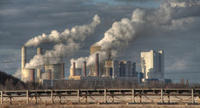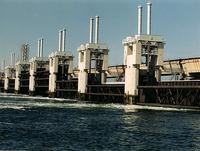-
Reliance on BP, feeble regulations make U.S. partially culpable in Deepwater Horizon oil spill
A recent ruling by a federal judge that BP was “grossly negligent” in the 2010 Deepwater Horizon oil rig spill in the Gulf of Mexico placed the majority of blame on the multinational oil and gas company. Although not on trial in this case, the federal government was also culpable in the largest oil spill in U.S. history, according to a new paper. Based on reports from the National Commission on the BP Deepwater Horizon Oil Spill and Offshore Drilling, the Chief Council’s Report and other government documents, the report’s authors determined that the government’s reliance on market-based accountability mechanisms and its failure to implement a regulatory process based on a mutually agreed upon set of robust standards and voluntary information disclosure led to the largest oil spill in U.S. history.
-
-
As sea level rises, coastal communities brace for more frequent, destructive tidal flooding
Today, many coastal communities are seeing more frequent flooding during high tides. As sea level rises higher over the next fifteen to thirty years, tidal flooding is expected to occur more often, cause more disruption, and even render some areas unusable — all within the time frame of a typical home mortgage. An analysis of fifty-two tide gauges in communities stretching from Portland, Maine to Freeport, Texas shows that most of these communities will experience a steep increase in the number and severity of tidal flooding events over the coming decades, with significant implications for property, infrastructure, and daily life in affected areas. The report warns that given the substantial and nearly ubiquitous rise in the frequency of floods at these fifty-two locations, many other communities along the East and Gulf Coasts will need to brace for similar changes.
-
-
Mopping up toxic fire-fighting chemicals

Australian scientists have come up with the solution to a world-wide pollution problem — how to mop up the toxic residues left after the use of special foams to fight fires. The technology uses a modified clay to soak up potential cancer-causing substances in the foam used by fire fighters, defense facilities, and airports worldwide to suppress fires.
-
-
Research powerhouses team up to develop climate models for energy applications
Eight national laboratories, four academic institutions, and one private-sector company are partnering in the Climate Modeling for Energy, or ACME, project, designed to accelerate the development and application of fully coupled, state-of-the-science Earth system models for scientific and energy applications. The project will focus initially on three climate-change science drivers and corresponding questions to be answered during the project’s initial phase.
-
-
California communities running out of water
Since January, a number of California communities in the Central Valley have been experiencing such extreme drought that they have been placed on a “critical water systems” list — a ranking indicating that the areas could run completely dry within sixty days. Many of these areas have had wells dried up since July.
-
-
Better planetary vital signs should replace 2° C warming goal as targets for climate action
As climate instability increases across the planet, limiting global surface air temperature increase above pre-industrial levels to an average of 2° C (3.6° F) has become a popular metric for success in the public eye. Two researchers argue, however, that the goal is a misleading one. Though it is a relatively tangible concept to appreciate, the standard does not correlate well to prescribed government actions such as limiting fossil fuel use or establishing carbon markets. “Scientifically, there are better ways to measure the stress that humans are placing on the climate system than the growth of average global surface temperature — which has stalled since 1998 and is poorly coupled to entities that governments and companies can control directly,” the researchers say.
-
-
California agriculture faces greatest water loss ever seen
California produces nearly half of U.S.-grown fruits, nuts, and vegetables, and nearly a quarter of the nation’s milk and cream. Across the nation, consumers regularly buy several crops grown almost entirely in California, including tomatoes, carrots, broccoli, almonds, walnuts, grapes, olives, and figs. Researchers show that California agriculture is weathering its worst drought in decades due to groundwater reserves, but the nation’s produce basket may come up dry in the future if it continues to treat those reserves like an unlimited savings account.
-
-
California crippling drought linked to climate change: Scientists
The extreme atmospheric conditions associated with California’s crippling drought are far more likely to occur under today’s global warming conditions than in the climate that existed before humans emitted large amounts of greenhouse gases. Researchers used a novel combination of computer simulations and statistical techniques to show that a persistent region of high atmospheric pressure hovering over the Pacific Ocean that diverted storms away from California was much more likely to form in the presence of modern greenhouse gas concentrations.
-
-
New approach can change climate negotiations
Researchers argue that the most important recent innovation in the discussion over how to slow down global warming is the adoption of a “cumulative emissions” approach to emissions of carbon dioxide. The researchers say that though, in the short term, this promises to challenge negotiators trying to achieve a meaningful international climate change agreement, in the longer term it ought to help them focus on the things that matter most. The virtue of using the cumulative emissions approach is clarity: By finding a simpler way to express the overall scale of the problem, the approach – and the IPCC and Calderón reports — give governments and other players less room to pretend that opportunistic or short-term tweaks to emissions paths are sufficient to meet the goals they have set themselves.
-
-
Increased use of natural gas will have little effect on CO2 emissions: Study

Abundant supplies of natural gas will do little to reduce harmful U.S. emissions causing climate change, according to researchers. They found that inexpensive gas boosts electricity consumption and hinders expansion of cleaner energy sources, such as wind and solar.
-
-
Reduce river pollution through water-quality trading
Allowing polluters to buy, sell, or trade water-quality credits could significantly reduce pollution in river basins and estuaries faster and at lower cost than requiring the facilities to meet compliance costs on their own, a new study finds. The scale and type of the trading programs, though critical, may matter less than just getting them started.
-
-
NSF awards $15 million in second round of coastal sustainability grants
More than half the world’s human population lived in coastal areas in the year 2000; that number is expected to rise to 75 percent by 2025. If current population trends continue, projections are for the crowded U.S. coast to see its population grow from 123 million people to nearly 134 million people by 2020. In wake of storms such as Hurricanes Sandy and Isaac, the NSF awards focus on better management of coastal environments.
-
-
To stay below 2°C warming, coal’s rapid phase out is essential, but not enough

A rapid phase out of coal as an electricity source by 2050 would reduce warming by half a degree, according to a new study. The study authors ran a number of scenarios around phasing out fossil fuel emissions from the electricity sector, which produces around 40 percent of global C02 emissions. The electricity sector needs to be decarbonized faster than other sectors, but instead is heading in the opposite direction, increasing carbon intensity and significantly driven by increased coal use, and making it one of the largest sources of recent carbon emission increases.
-
-
Cities seek new ways to cope with sea level rise – and look to the Dutch for advice

Scientists predict a “tenfold increase” in the frequency of hurricanes and other storms, as well as sea-level rise of eleven to twenty-four inches within a little more than three decades – and planners and managers in U.S. coastal cities are looking at new ways to prepare their cities’ infrastructure for these challenges. In New York and New Orleans, city planners are studying the experience of the Dutch, who have gained a lot of experience – and fame — for their water control methods.
-
-
Rural towns lose to urban centers in competition for coastal protection funding
Infrastructure protection planners say there are only three ways coastal communities can defend themselves against rising sea levels: defend the shoreline with both natural and man-made barriers; raise key infrastructure such as buildings and roads; or retreat from the shoreline. Each of these options costs a fortune to follow. Smaller, more rural coastal communities in many states are finding that they are having a hard time competing with more powerful interests in coastal urban cities over funding for protection against sea-level rise.
-
- All
- Regional
- Water
- Biometrics
- Borders/Immig
- Business
- Cybersecurity
- Detection
- Disasters
- Government
- Infrastructure
- International
- Public health
- Public Safety
- Communication interoperabillity
- Emergency services
- Emergency medical services
- Fire
- First response
- IEDs
- Law Enforcement
- Law Enforcement Technology
- Military technology
- Nonlethal weapons
- Nuclear weapons
- Personal protection equipment
- Police
- Notification /alert systems
- Situational awareness
- Weapons systems
- Sci-Tech
- Sector Reports
- Surveillance
- Transportation
Advertising & Marketing: advertise@newswirepubs.com
Editorial: editor@newswirepubs.com
General: info@newswirepubs.com
2010-2011 © News Wire Publications, LLC News Wire Publications, LLC
220 Old Country Road | Suite 200 | Mineola | New York | 11501
Permissions and Policies
Editorial: editor@newswirepubs.com
General: info@newswirepubs.com
2010-2011 © News Wire Publications, LLC News Wire Publications, LLC
220 Old Country Road | Suite 200 | Mineola | New York | 11501
Permissions and Policies
